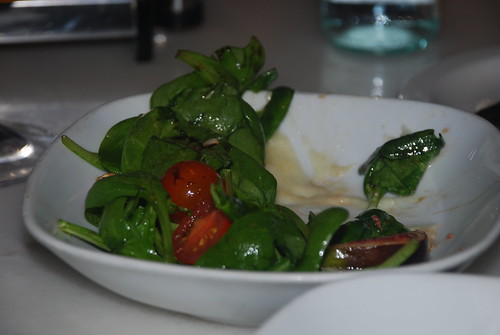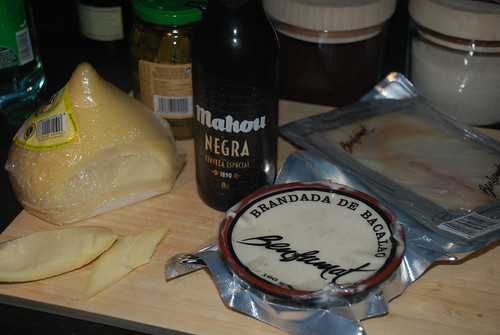Hidden Stinky Treasure Salad
Tuesday, 13 January 2009 by kinakoJam

I’m not too down with mould – the stuff on French cheeses sometimes looks a lot like strains I’ve encountered at the back of fridges or at the bottom of shower curtains. By comparison, the blue streaks in gorgonzola look positively clinical –an astringent shade of mould, like toilet cleaner, blurred at the edges as if with a paint brush. Not festering, wet and splotchy.
I’m quite into fermented beans and some fermented fish products though, so I wouldn’t say I’m against partially decomposed food. I’ve grown to enjoy the whole melted rounds of goat’s cheese that come atop salads in Germany: the same cheese that I used to think tasted like vomit due to the pungency and lingering acidity in the back of the throat.
The taste for super-funky foodstuffs seems to be something that can be cultivated, rather like the moulds themselves. Maybe my taste buds are simply dimming. Maybe at 70 I’ll be eating bowls of candied dried fish sprinkled with fermented natto-beans for breakfast, like cereal.
But I am still challenged by the small cheese shop in the centre of town that specialises in French cheeses, with that sock-like smell that wafts out when you pass the front door, and the multi-coloured, botanical garden of moulds in the window.
When we were in Barcelona in November, I found that Spanish cheeses suit my timid yet adventurous palate very well. There are lots of raw milk and goat’s milk cheeses in Spain, and a lot of interesting textures, from the curd-like pliancy of the breast-shaped Tetilla, to chewy and crumbly aged caciocavallo or manchego. The Cabrales blue cheese is not as intense as some cheese writers make out, its enicillium cabralensis spores cultivated in humid caves.
I had read of one Spanish food commentator’s favourite cheese being Torta di Casar, a ewe’s milk cheese only 7% of which is exported abroad. I bought one from the cheese section of the supermarket under El Corte Ingles for 17 euros. The rind was nut brown and in its centre lichen-like white splotches were starting to form with, even more disturbingly, moist rust-coloured edges. I imagine the centre as being semi-liquid and fetid smelling.
So I did not eat it in Barcelona, instead wrapping it well and carrying it home to Germany in my hand luggage, to share with some friends who I knew enjoyed the whiffier side of life. We thought to serve it with crackers, but worrying that this would be too intense, decided instead to serve it in the manner of a delicious salad we’d eaten at Barcelona’s Bar Mut (picture above).
There, a smear of melted goat’s cheese (torta di cabra) spread on the plate lurked at the bottom of a refreshing salad of spinach, warmed walnuts, cherry tomatoes and fresh figs, balancing out the pungent cheese perfectly. It was very enjoyable to dig out little bits of hidden cheese with each forkful of leaves.
The improvised home version turned out to be just as good as Bar Mut’s rendition. I highly recommend using this ‘hidden smelly treasure’ salad technique next time you have a ripe cheese you aren’t sure what to do with.
The Torta di Casar was not liquid inside as I had expected, though very soft, so we softened it further under the grill for just a few seconds. The taste was funky enough to make a good counterpoint with the salad, to which we added a honey-lemon dressing and dried figs in place of fresh.
This was not a scary cheese, despite its florid casing: nutty and smooth with a round pungent flavour, almost reminiscent of fish sauce. As everybody finished their salads and began digging into the cheese with spoons and spreading it on crackers, I realised that Torta di Casar is best eaten by itself. Let me rephrase that: it is best eaten by oneself.
Muttering that they should not fill themselves up on cheese before I served the soup, I whisked the last crumbs of cheese away. It's hard to imagine coveting a Vieux Boulogne so, but who knows? As my age ripens, hopefully my hang ups will soften like ewe's milk curds in a warm, dark place.

Good things: tetilla cheese with 'bacalao' cod products and dark beer.
